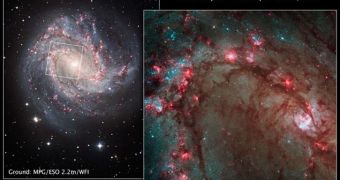Since the crew of space shuttle Atlantis repaired the famous Hubble Space Telescope, earlier this year, the quality of the scientific data coming in from the observatory has increased substantially. Its new instruments now function flawlessly, having undergone a few months of testing, calibration and preliminary observations after the May mission. One of the most recent works of art that the telescope snapped was a photo of the Southern Pinwheel Galaxy, or M83, and of the star-forming processes that took place within, Space reports.
During the Atlantis mission, the seven astronauts aboard the shuttle changed Hubble's main “eyes,” the Wide Field Camera 2 (WFC2) with the WFC3. The latter instrument is a massive upgrade from its predecessor's capabilities, and can function at a much higher range, providing even more accurate photos of various cosmic targets. M83 was one of the galaxies that simply had to be photographed. Its main point of interest is its nucleus, which shows signs of intense stellar formation, much more than the core of our own Milky Way.
In the new image, massive numbers of blue and red supergiants can be clearly made out. Astronomers estimate that they are in the hundreds-of-thousands range, surrounded by ancient swarms of globular star clusters, and by hundreds of younger star clusters. The new image only concentrates on a portion of the galaxy's core. Because of its appearance, M83 has been nicknamed the Southern Pinwheel galaxy. The image to the left was collected by the European Southern Observatory (ESO) telescope, and shows the area on which the WFC3 focused during the latest “photo shoot.”
The wealth of information present in the new image is so great because the camera had a very broad range, and it was able to observe light from the near-infrared to the ultraviolet wavelengths of the electromagnetic spectrum. The tracks of more than 60 supernova blasts are clearly visible in this image. This number is considerably larger than the one inferred from other observations of the same structure. The Pinwheel Galaxy is located some 15 million light-years away, in the direction of the Southern constellation of Hydra.

 14 DAY TRIAL //
14 DAY TRIAL //